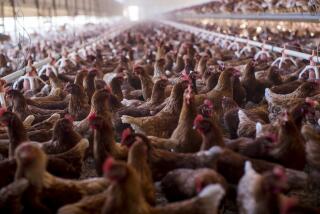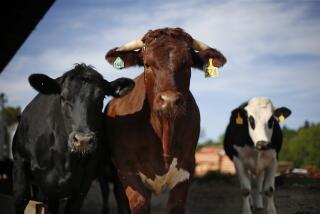Use of Antibiotics in Farm Animals
- Share via
The extensive press coverage given to salmonella-contaminated poultry and antibiotic drug residues in meat, eggs and milk has missed the point. The question is why are these drugs being used in the first place and why are the meat, eggs and milk so permeated with bacteria?
The answer can be traced to the indiscriminate use of antibiotics in factory farming which has resulted in the appearance of mutant bacterial strains virtually invulnerable to antibiotic therapy.
Factory farms are designed to maximize profits in meat and dairy production, but have succeeded in maximizing conditions for disease contagion. To keep these factories productive, managers must resort to a wide array of medical drugs and other chemical inputs. Instead of using sensible husbandry and strategies of disease prevention and natural animal health, factory producers rely on antibiotics, powerful drugs, hormones and other stimulants.
Today, antibiotic usage in food animals accounts for about half of all antibiotics produced in the U.S. In 1979, the Office of Technology Assessment reported that 99% of all poultry, 90% of swine, and 70% of cattle and veal calves routinely receive antibiotics. Currently, antibiotics such as tetracycline, penicillins, sulfonaides, streptomycin, and macrolides are added in sub-therapeutic amounts to animal feed for growth production or prevention of disease. Placed in a situation which would normally make an otherwise healthy animal sick, this sub-therapeutic administration of antibiotics keeps them disease-free, but at a deadly price to human health.
Over 20 years ago, The New England Journal of Medicine warned: “It appears that unless drastic measures are taken very soon, physicians may find themselves back in the pre-antibiotic middle ages in treatment of infectious disease.” When penicillin was first introduced, fewer than 10% of staphylococcal strains isolated from patients and carriers were resistant to penicillin. Now, over 90% of staphylococci are resistant to penicillin.
In 1979, just as the evidence became compelling that animal products were passing drug-resistant bacteria to humans, Congress prohibited the Food and Drug Administration from restricting antibiotic use in raising animals for food. This imprudent concession to the demands of agribusiness is one of the reasons why salmonella bacteria is flourishing in meat and eggs, and why antibiotic residues are appearing in milk.
Congress must take steps to eliminate the indiscriminate use of antibiotics dictated by factory farming.
MELINDA CALLEIA, Chairman
KENNETH P. STOLLER, M.D.
American Assn. for Science
and Public Policy, Los Angeles






